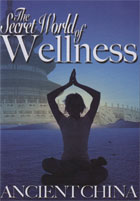
The Secret World of Wellness 2007
Distributed by Janson Media, 88 Semmons Road, Harrington Park, NJ 07640; 201-784-8488
Produced by Langbein & Skalnik Media
Directed by Wolfgang Thaler, Kurt Langbein, Peter Bardehle
DVD , color, 52 min., 3 DVDs
Jr. High - Sr. High
Alternative Medicine
Date Entered: 03/19/2009
Reviewed by Justin Cronise, University at Buffalo, State University of New YorkThe Secret World of Wellness is comprised of three films that examine alternative healing practices from advanced early civilizations: Ancient China, Ancient Rome and Ancient India. While each hour-long episode has potentially interesting information, the films all follow the same formula of an incoherent structure, often-ridiculous historical re-enactments, and a droning narration that detracts from the content.
Ancient China is the most focused of the three films, mostly covering traditional Chinese herbal remedies and how they are used in the rapidly modernizing industrial nation that China is today. There are moments of insight into the traditional Chinese culture and some great visual footage. This film also has the advantage of the natural beauty of the mountainous landscapes. Unfortunately, the historical re-enactments that are interspersed throughout the film distract from any serious educational value, and include a brief but over-done battle scene of an astonishing number of Chinese men in highly detailed costumes with armor and weapons.
While Ancient China may be the best of the three films, I can only recommend with reservations. The concepts of wellness and diversity are valuable, but there are likely shorter films available that focus more on herbal remedies, the Chinese martial arts, or acupuncture. School libraries might only consider adding this film to their collection for use in classes that request this item in particular, or for use in an excerpted form.
Ancient Rome is the weakest and least coherent of the three films, and is not recommended. What starts off with the healing power of water and hot mineral baths meanders into Italian food and fashion. There are scripted-looking testimonials and computer graphics that are not convincing enough to demonstrate the viability of far-fetched wellness concepts. The flashbacks to historical re-enactments are particularly nonsensical in this film, and there are not only a number of scenes with frontal nudity, but also a sex scene in a crowded room that may not be appropriate for classrooms. As a requisite with each film in the series, there is an overdone battle scene here as well, this time with armored Roman-looking men fighting on horses.
Although Ancient Rome has some individual merit in visual footage, it could have been made into a shorter and more focused film, as well as easily boosted the content with better narrative dialogue. However, this film is so poorly edited that it is not recommended for any library collection, except possibly for use as punishment.
Ancient India offers a view of India’s current alternative medical culture that is based on Ayurvedic traditions developed by the Indus culture over thousands of years. The Ayurvedic tradition is based on holistic treatments that address the body as a whole, rather than symptomatic like modern Western medicine. This film, however, acts mostly as an advertisement for Ayurvedic treatments at the featured wellness center, with scripted-sounding interviews and testimonials from patients. Cut in and around everything is an extended historical re-enactment with a master and apprentice, as well as a surprisingly brief and inexplicable – for the work that it must have involved – war scene with hundreds of people and lots of elephants dressed up and fighting.
Exposure to such ideas as the Ayurvedic view of holistic wellness as an adjunct or alternative to Western medical practice is valuable for students and adults alike, but this film is much too long to hold anyone’s attention. A school library might include this film in their media collection to support world culture studies or other diversity-based classes, but it is recommended only for excerpted viewing.